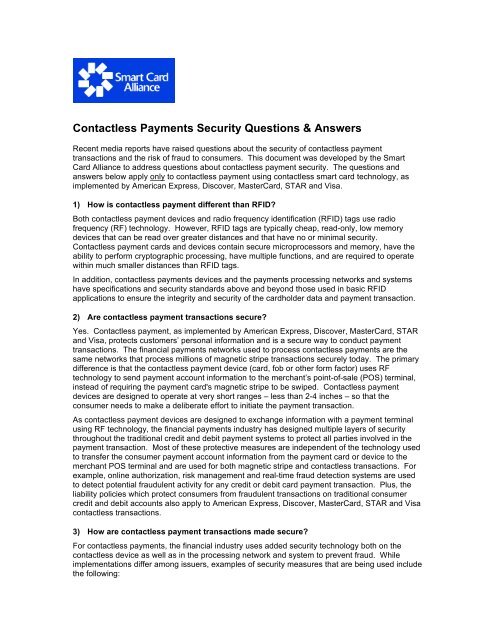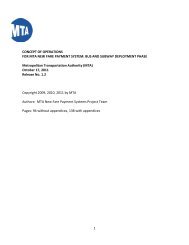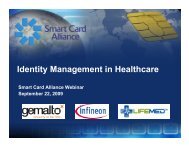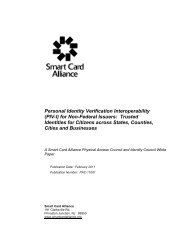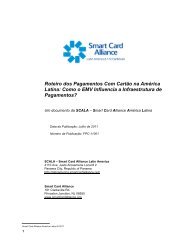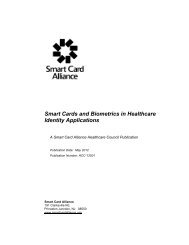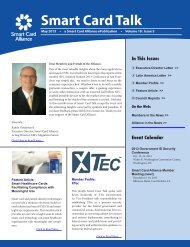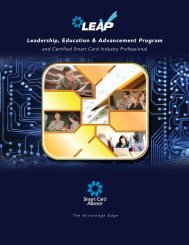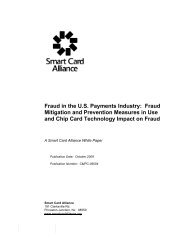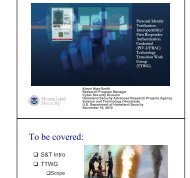Contactless Payments Security Questions & Answers - Smart Card ...
Contactless Payments Security Questions & Answers - Smart Card ...
Contactless Payments Security Questions & Answers - Smart Card ...
You also want an ePaper? Increase the reach of your titles
YUMPU automatically turns print PDFs into web optimized ePapers that Google loves.
<strong>Contactless</strong> <strong>Payments</strong> <strong>Security</strong> <strong>Questions</strong> & <strong>Answers</strong><br />
Recent media reports have raised questions about the security of contactless payment<br />
transactions and the risk of fraud to consumers. This document was developed by the <strong>Smart</strong><br />
<strong>Card</strong> Alliance to address questions about contactless payment security. The questions and<br />
answers below apply only to contactless payment using contactless smart card technology, as<br />
implemented by American Express, Discover, Master<strong>Card</strong>, STAR and Visa.<br />
1) How is contactless payment different than RFID?<br />
Both contactless payment devices and radio frequency identification (RFID) tags use radio<br />
frequency (RF) technology. However, RFID tags are typically cheap, read-only, low memory<br />
devices that can be read over greater distances and that have no or minimal security.<br />
<strong>Contactless</strong> payment cards and devices contain secure microprocessors and memory, have the<br />
ability to perform cryptographic processing, have multiple functions, and are required to operate<br />
within much smaller distances than RFID tags.<br />
In addition, contactless payments devices and the payments processing networks and systems<br />
have specifications and security standards above and beyond those used in basic RFID<br />
applications to ensure the integrity and security of the cardholder data and payment transaction.<br />
2) Are contactless payment transactions secure?<br />
Yes. <strong>Contactless</strong> payment, as implemented by American Express, Discover, Master<strong>Card</strong>, STAR<br />
and Visa, protects customers’ personal information and is a secure way to conduct payment<br />
transactions. The financial payments networks used to process contactless payments are the<br />
same networks that process millions of magnetic stripe transactions securely today. The primary<br />
difference is that the contactless payment device (card, fob or other form factor) uses RF<br />
technology to send payment account information to the merchant’s point-of-sale (POS) terminal,<br />
instead of requiring the payment card's magnetic stripe to be swiped. <strong>Contactless</strong> payment<br />
devices are designed to operate at very short ranges – less than 2-4 inches – so that the<br />
consumer needs to make a deliberate effort to initiate the payment transaction.<br />
As contactless payment devices are designed to exchange information with a payment terminal<br />
using RF technology, the financial payments industry has designed multiple layers of security<br />
throughout the traditional credit and debit payment systems to protect all parties involved in the<br />
payment transaction. Most of these protective measures are independent of the technology used<br />
to transfer the consumer payment account information from the payment card or device to the<br />
merchant POS terminal and are used for both magnetic stripe and contactless transactions. For<br />
example, online authorization, risk management and real-time fraud detection systems are used<br />
to detect potential fraudulent activity for any credit or debit card payment transaction. Plus, the<br />
liability policies which protect consumers from fraudulent transactions on traditional consumer<br />
credit and debit accounts also apply to American Express, Discover, Master<strong>Card</strong>, STAR and Visa<br />
contactless transactions.<br />
3) How are contactless payment transactions made secure?<br />
For contactless payments, the financial industry uses added security technology both on the<br />
contactless device as well as in the processing network and system to prevent fraud. While<br />
implementations differ among issuers, examples of security measures that are being used include<br />
the following:
• Industry standard encryption. At the card level, each contactless card can have its own<br />
unique built-in secret "key" that uses standard encryption technology to generate a<br />
unique card verification value, cryptogram or authentication code that exclusively<br />
identifies each transaction. No two cards share the same key, and the key is never<br />
transmitted.<br />
• Authentication. The issuers verify that the contactless payment transaction has a valid<br />
card verification value, authentication code or cryptogram before authorizing the<br />
transaction. Therefore, at the system level, issuers have the ability to automatically<br />
detect and reject any attempt to use the same transaction information more than once.<br />
• Confidentiality. The processing of contactless payments does not require the use of the<br />
actual cardholder name in the transaction. In fact, best practices being used within the<br />
industry do not include the cardholder name in the contactless chip.<br />
• Control. <strong>Card</strong>holders control both the transaction and the card throughout the<br />
transaction. <strong>Card</strong>holders do not have to hand over either a card or their account<br />
information to a clerk during a contactless transaction.<br />
4) Can card information be read from the contactless payment card or device without the<br />
consumer knowing?<br />
<strong>Contactless</strong> payment devices are designed to be read when in close proximity to a capable<br />
payment terminal device. The contactless payment devices, as well as the terminals and<br />
network, have been designed to ensure that the customer initiates the transaction by holding the<br />
contactless payment device within 2-4 inches of the payment terminal. In the event that a<br />
motivated individual did read the information from a contactless payment device, the security<br />
features designed into the device, the payment terminal and the payment system (see questions<br />
2 and 3) would mitigate against the information being used for fraudulent transactions. In reality,<br />
the industry has only seen this attack carried out in demonstrations, not used to conduct actual<br />
fraud.<br />
5) Can information that is read from the contactless payment device be used to create<br />
fraudulent transactions?<br />
See questions 2 and 3 for examples of the security measures that are used at the card and<br />
system level to prevent fraudulent transactions.<br />
The cardholder information that is used during a contactless payment transaction is of little to no<br />
use in creating fraudulent payment transactions. The security implementation currently used by<br />
the different payment brands causes the contactless device-generated transaction information to<br />
change every time a reader reads the device. This transaction information is generated using a<br />
strong encryption key that is known only to the financial issuer. Issuers can verify this dynamic<br />
card information before approving a payment transaction from an authorized reader.<br />
Established best practices can be used by Internet and telephone/mail order merchants to<br />
prevent the use of stolen card data, including requiring the card verification value/card verification<br />
code/card ID that is printed on the card and/or the cardholder zip code for address verification to<br />
complete any purchase. None of this information is used in a contactless payment transaction so<br />
would not be available for an Internet or phone purchase.<br />
The industry has not seen attacks on contactless payment cards result in actual fraud.<br />
6) What steps can consumers take to protect their contactless payment cards?<br />
While all the issuers continue to enhance and evolve their security to meet the challenges of<br />
protecting their customers’ sensitive information, there are additional ways consumers can<br />
minimize the risk of having their payment card data read by a potential thief by taking a few<br />
common precautions, such as not leaving their contactless payment card or key fob unattended
for a length of time. Consumers should take the same precautions they would with any other type<br />
of payment card.<br />
If a consumer believes their card account or their information has been put at risk, they should<br />
contact the issuer. Additionally, liability policies which protect consumers for traditional consumer<br />
credit and debit accounts also apply to American Express, Discover, Master<strong>Card</strong>, STAR and Visa<br />
contactless transactions.<br />
7) Should consumers be worried about carrying contactless cards?<br />
No. Because of the many layers of security throughout the payment system that limit fraud with<br />
all payment cards and the unique security features used in contactless payment transactions,<br />
there have been no reports of this type of actual fraud.<br />
This Q&A document has recently been updated as a result of media reports describing concerns<br />
about RFID fraud, sometimes referred to as so-called "electronic pickpocketing."<br />
About the <strong>Smart</strong> <strong>Card</strong> Alliance<br />
The <strong>Smart</strong> <strong>Card</strong> Alliance is a not-for-profit, multi-industry association working to stimulate the<br />
understanding, adoption, use and widespread application of smart card technology. Through<br />
specific projects such as education programs, market research, advocacy, industry relations and<br />
open forums, the Alliance keeps its members connected to industry leaders and innovative<br />
thought. The Alliance is the single industry voice for smart cards, leading industry discussion on<br />
the impact and value of smart cards in the U.S. and Latin America. For more information please<br />
visit http://www.smartcardalliance.org.


